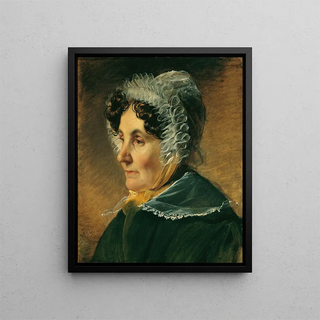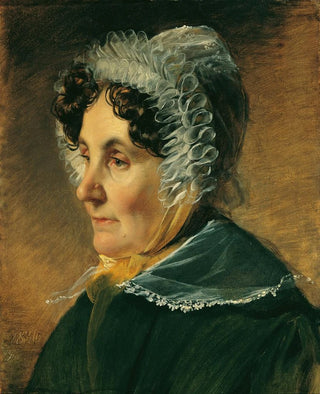Art print | Theresia Amerling, mother of the artist - Friedrich von Amerling


View from behind

Frame (optional)
Theresia Amerling, mother of the artist - Friedrich von Amerling – Captivating introduction
In the vibrant universe of 19th-century art, certain works stand out for their ability to evoke deep emotions and intimate stories. "Theresia Amerling, mother of the artist - Friedrich von Amerling" is one such creation that, through its apparent simplicity, reveals a striking emotional complexity. This artwork does not merely depict a mother; it immortalizes a bond, a palpable tenderness between a son and his mother, while fitting into a rich artistic context where portraits often echo a particular era and culture. In this painting, the viewer is invited to immerse themselves in an atmosphere of gentleness and respect, where each brushstroke bears witness to sincere admiration.
Style and uniqueness of the work
The uniqueness of this piece lies in Friedrich von Amerling's delicate and meticulous style, who excels in portraiture. Light plays a predominant role, caressing Theresia's features, highlighting the softness of her face and the serene expression that inhabits her. The chosen colors, both warm and soothing, create a visual harmony that invites contemplation. Amerling, a true master of his craft, knows how to capture the essence of his subject, making every detail meaningful. The pose, with an attitude that is both natural and composed, reflects not only the personality of the mother but also the affection her son bears for her. This artwork is not just a simple representation; it is an ode to motherhood, tenderness, and the beauty of family bonds.
The artist and his influence
Friedrich von Amerling, born in 1803 in Vienna, is one of the most emblematic portraitists of his time. Trained in the finest academies, he managed to combine tradition and innovation, drawing inspiration from old masters while developing a personal style. His work is marked by impressive technical precision and particular attention to detail. Amerling does not limit himself to depicting his subjects; he seeks to capture their essence, to reveal their character through their expressions and postures. This approach has influenced many artists of

Matte finish

View from behind

Frame (optional)
Theresia Amerling, mother of the artist - Friedrich von Amerling – Captivating introduction
In the vibrant universe of 19th-century art, certain works stand out for their ability to evoke deep emotions and intimate stories. "Theresia Amerling, mother of the artist - Friedrich von Amerling" is one such creation that, through its apparent simplicity, reveals a striking emotional complexity. This artwork does not merely depict a mother; it immortalizes a bond, a palpable tenderness between a son and his mother, while fitting into a rich artistic context where portraits often echo a particular era and culture. In this painting, the viewer is invited to immerse themselves in an atmosphere of gentleness and respect, where each brushstroke bears witness to sincere admiration.
Style and uniqueness of the work
The uniqueness of this piece lies in Friedrich von Amerling's delicate and meticulous style, who excels in portraiture. Light plays a predominant role, caressing Theresia's features, highlighting the softness of her face and the serene expression that inhabits her. The chosen colors, both warm and soothing, create a visual harmony that invites contemplation. Amerling, a true master of his craft, knows how to capture the essence of his subject, making every detail meaningful. The pose, with an attitude that is both natural and composed, reflects not only the personality of the mother but also the affection her son bears for her. This artwork is not just a simple representation; it is an ode to motherhood, tenderness, and the beauty of family bonds.
The artist and his influence
Friedrich von Amerling, born in 1803 in Vienna, is one of the most emblematic portraitists of his time. Trained in the finest academies, he managed to combine tradition and innovation, drawing inspiration from old masters while developing a personal style. His work is marked by impressive technical precision and particular attention to detail. Amerling does not limit himself to depicting his subjects; he seeks to capture their essence, to reveal their character through their expressions and postures. This approach has influenced many artists of






